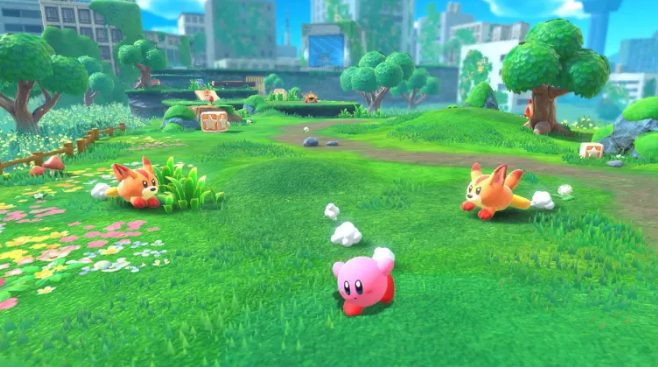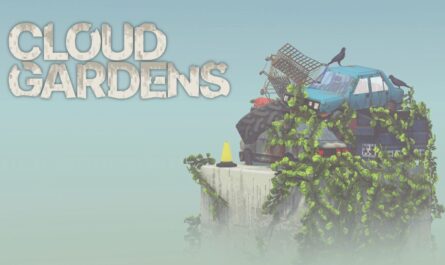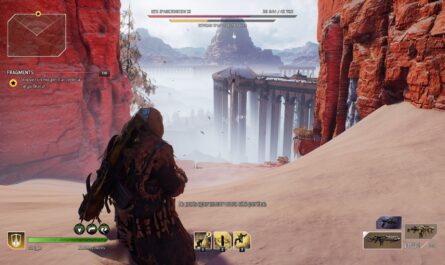He is pink, soft as a cloud, with a bottomless stomach and an insatiable power to absorb everything in his path. He is Kirby, the child of HAL Laboratory who was lovingly adopted by Nintendo, appeared as a guest in several of its franchises and who followed very closely the path of its most famous icon – Mario. Now, Kirby has happily turned 30 years old: we can, now and for sure, say that Kirby also followed parallel development paths with Mario.
From the 2D, side-scrawling paths of the original titles with a single ability, he gradually acquired his own powers (which gradually increased), his own 3D model, and even the ability to move around in 2.5D environments. Now, 30 years after the first black-and-white game on the Game Boy, Kirby returns for his first fully 3D adventure with Kirby and the Forgotten Land, a game that is easily the best in the series.
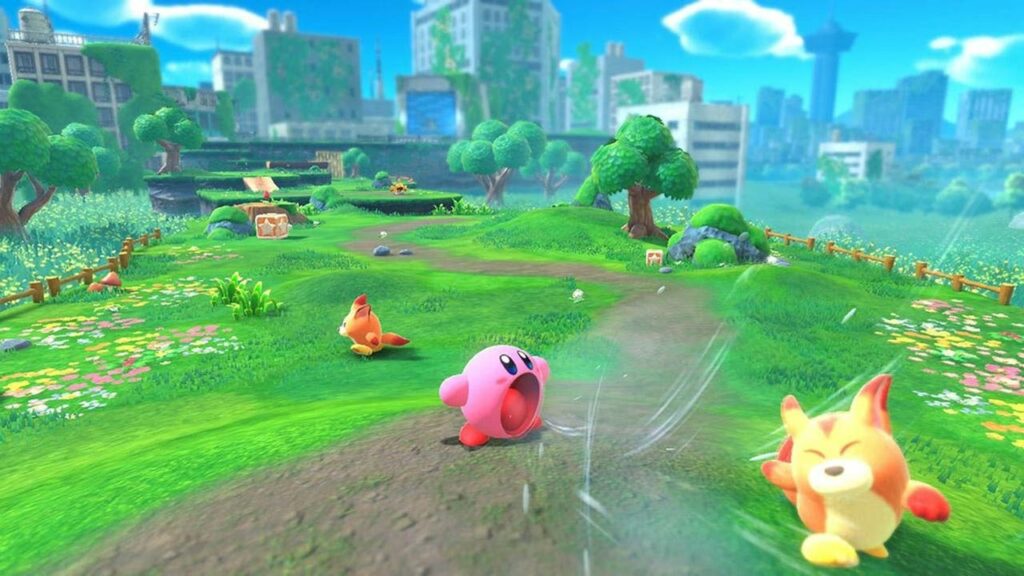
Do we use big words? The “best” game in the series? But of course. Kirby and the Forgotten Land is already the culmination of the creative concerns and experimentation of the people at HAL Laboratory. During the 30 years of the series’ existence, they “played” with many ideas and certainly learned a lot. Abilities, environments, enemies, cooperative multiplayer – it’s all in here. It’s just that now they go one step further and present us with a 3D adventure in large, open levels that allow for those two gameplay features that previous games in the series didn’t allow: experimenting with new powers and the element of exploration.
The new powers this time also interact with the environment, with fun and – often – explosive results, while the element of exploration, in our opinion always, is implemented to the best degree, to the point where it really surprises and urges the player to continue to looking…and being looked for.

Kirby’s New Journey begins with a cinematic where Kirby, a bunch of Waddle Dees, and a bunch of objects are absorbed by a mysterious portal that appears in the sky, transporting them to a new, lost world. The first level is a short tutorial, at the end of which the player has already formed an image of what Kirby and the Forgotten Land has to offer in terms of content and gameplay. Somewhere there, Kirby meets a new character, Elflin, who has been kidnapped by the animal enemies of the new dimension and who decides to stay with Kirby as he travels to the new dimension, rescuing the Waddle Dees of the world from their prison.
What Elfilin’s role is is something that is revealed at the end of the story, 32 levels and six worlds later, through a story that offers little surprise to players. After all, never before was the story of a Kirby title one of the special and most important features of each title. What really interested players was the platforming element of the gameplay and gradually exploring and experimenting with Kirby’s abilities. And, if nothing else, Kirby and the Forgotten Land doesn’t let us down in that regard at all.

However, this is where our first gripe with the game comes in. From the first moment Nintendo gave us the teaser of Kirby and the Forgotten Land, we had the impression that the game was the first 3D Kirby to take place in open-world environments, following the standards of Super Mario Odyssey. In the end, though, it was all just an illusion. If we could put it more precisely, we would say that Kirby and the Forgotten Land follows more of the design patterns of Super Mario 3D World – individual worlds, with a certain number of levels each, but also with a number of mini-levels, which work more as complementary, but essential to the progression of the adventure.
It would be completely unfair to say that the level design doesn’t work well at all. Each level hides several surprises in its design. Hidden corridors, rooms and areas that are only unlocked through the right designs, areas that become accessible with the right items are just some of the features of the levels. Each individual level has its own unique design and adds its own touch to the canvas of our experience, which we enjoyed in HAL Laboratory’s first attempt to break away from 2D and 2.5D stereotypes.
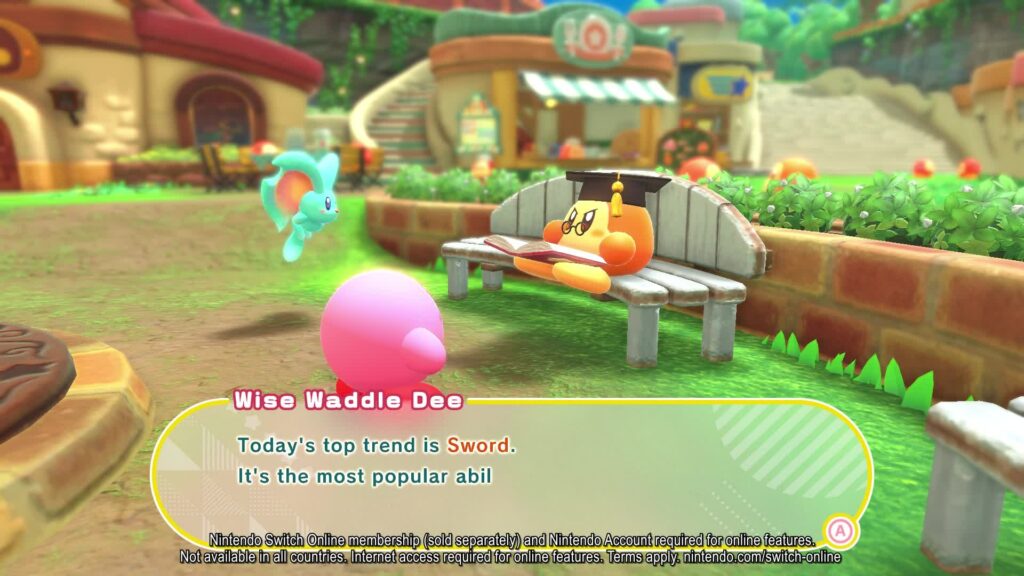
However, comparing the path that 3D Mario titles have followed, we wish the developers had shown faster reflexes and experimented with worlds rather than levels. So we reserve one for the next game in the series. In no way, however, do we want to give this comment a negative connotation. There is room for improvement. On a tangible level, however, we have the most impressive level design in a game of the series, without forgetting for a moment the consummate technician of the field, which conveys exactly as it should this sense of the dreamy, the fairy-tale, which both the titles of the Kirby series, as and a number of first-party Nintendo titles have persistently adopted it over the years. And that says a lot in itself.
Continuing with the levels, we must note that on the podium of the originality of the gameplay, the first place is shared, together with the element of exploration, and the abilities. Skills are a familiar element. Until now, it was enough for Kirby to absorb certain opponents and gain some virtual transformations. This time, however, things change.

The ability mechanic includes a base of 12 basic Copy Abilities, which for the first time in the history of the titles can be evolved. Scattered throughout the levels are blueprints of advanced abilities, which can make basic abilities even more powerful, allowing the player to fully adapt and cope with the most difficult situations as they arise along the adventure. Most can be evolved twice, with some reaching all three forms of evolution, drastically changing how we navigate the levels and how effective our conflicts can be with level monsters and bosses as well.
But the skill area isn’t just limited to what we get from level creatures. Kirby now gains the ability to absorb entire objects as well. Up until and before the end of the main campaign, Kirby will at certain times be able to absorb one of a total of nine special items on offer, with a separate item (and therefore a separate transformation) being offered in the final level of the main campaign.

Abilities gained from items drastically change our experience of combat, exploration, or both, as they can change both the player’s perspective on how levels are laid out and how easily some weaknesses can be discovered in certain enemies. These distinct transformations are, along with the 3D levels, the most significant evolutions the series presents. However, we do not hide our disappointment with how specifically directed and written their user interface is, and how quickly the game itself forces us to get rid of them when their use no longer serves any other purpose.
This limitation is completely in line with the design choice of the levels: in more open levels, there would be more flexibility in the use of special transformations, and probably an even greater number of items available – but that’s something we hope to see in someone future series title.
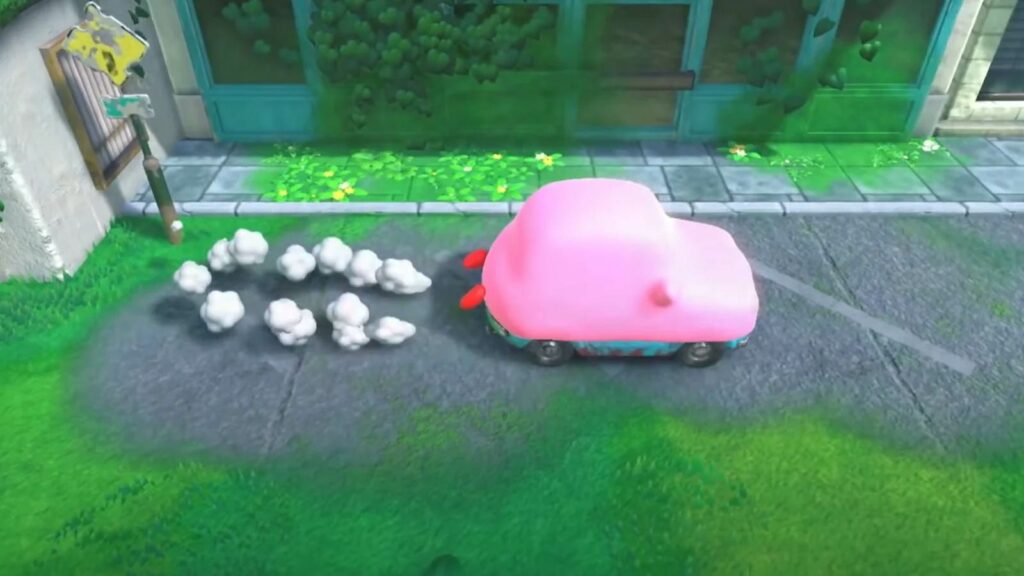
Kirby and the Forgotten Land is a title that unfolds in parallel on two fronts: the part of exploring the worlds and everything that unfolds in Waddle Dee Town, the central hub of the title. Exploring the levels won’t give us credit for hitting every box with our sword, dropping a bomb on every monster, or unleashing a mini-storm on a “suspicious” spot full of flowers. The reason why exploration is important is to discover and free all the Waddle Dees that have been absorbed into Kirby’s world and locked away in various places by the hostile inhabitants of the Forgotten Land.
The release of captive Waddle Dees is of great importance. Besides the sense of satisfaction that players can feel after some time of experimenting with the objects of the environment and with the design itself, Waddle Dees are responsible for “unlocking” each world’s boss fights. And their role, of course, does not end here, as the Waddle Dees returning to their hometown are responsible for the further development of the hub.

Every time Kirby goes back, it’s very likely that he’ll discover something new – either a new shop with items useful for his adventure, or some new activity. The various mini-games that exist in the city are not really worth anything for the series. But they manage to distract us from the main story for a reasonable amount of time, during which we will come out victorious. We will have earned enough coins, which we can invest in the city’s activities.
In particular, we’ll be able to buy items we need on our adventure, upgrade our abilities, and even spend a small fortune at the city’s crank machines, where we can acquire collectible figures of models and in-game opponents. Even if the player is not in the mood to participate in these activities, a walk around town will lead to hidden, pleasant surprises, and even easter eggs from the past. And so, the conclusion is one: the people of HAL Laboratory manage, with something as simple as a thought like the hub of the title, to give something back to the player, something that will make him have fun, or even reminisce about the old ones , powerful moments from the past.
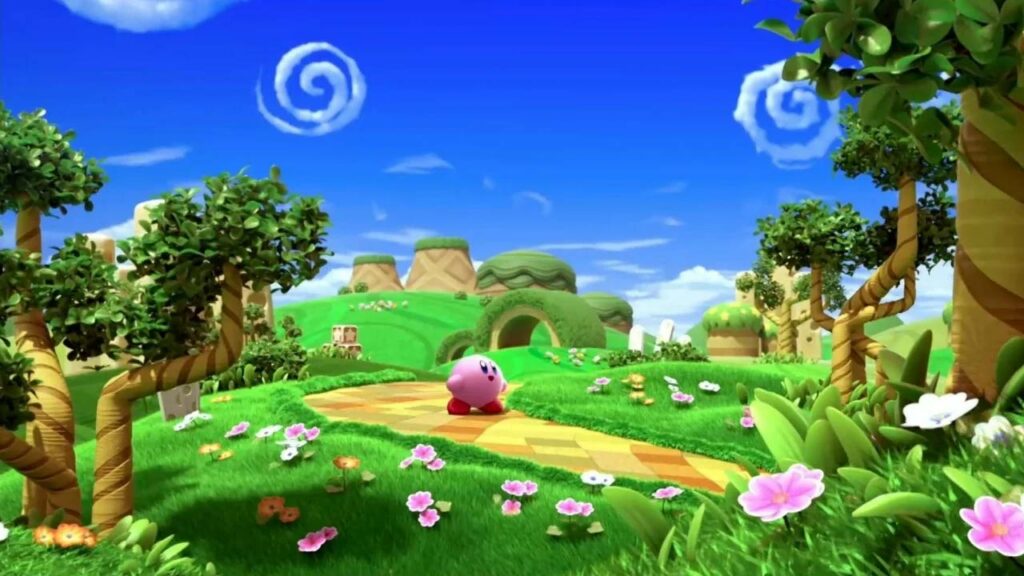
However, having reached the end of the title, we can say that there is little that the player can get from Waddle Dee Town for his adventure. Other than advanced abilities, nothing more will be needed to complete the game. The latest titles in the Kirby series do not offer any particular element of challenge to the player. And of course, Kirby and the Forgotten Land takes the exact same pattern, whether it’s in combat, or exploring levels and finding Waddle Dees.
Players should not be fooled by the initial message of the game, which asks the player to select the difficulty level. The title’s easy mode offers the player more health and less coins as a reward, as opposed to the title’s hard mode, where rewards are reversed in quantity. Even hard mode, however, cannot be a challenge, even for the most inexperienced player. The game often seems to pull the player by the hand and lead them down certain paths. Enemies that give specific copy abilities to the player and appear again and again, regardless of how many times they “fall” from their hand, are the game’s indirect way of explaining to the player that this copy ability is also the most useful for what lies below.

The levels themselves are full of healing items, with Kirby’s vitality barely under threat. Even if the player completes a level without discovering all the captured Waddle Dees, then the game starts and reveals a series of hints, with which the player is assured that one more playthrough is enough to discover everything that he did not find the first time. Boss fights are a very mild form of challenge. Not on the battle difficulty part – even the most inappropriate copy ability is enough to defeat a boss. Simply, the boss fights have some conditions to give us the Waddle Dees in their possession. This may mean that a boss must be defeated within a certain amount of time, using specific copy abilities (or none at all), even being defeated without causing damage to the player. This is, commonly, a form of difficulty that arises from the requirements, and not from the technique or from the way of dealing with them.
So, for better or worse, Kirby and the Forgotten Land will be as challenging to players as a simple walk in the park. To be honest, we only struggled in the last boss fight of the title and that’s because we are called to fight with only one force, while that is constantly changing. Again, though, careful observation of movements and some precise reactions on the player’s part is enough to successfully complete this obstacle as well.

The post-game content of the title slightly raises the level of difficulty, which of course will not be a particular problem, especially if we have access to the advanced forms of our abilities. So it becomes clear that Kirby and the Forgotten Land is a “family friendly” title, suitable for all those involved in the series from Kirby’s Dream Land, but also for the youngest members of the family. What’s more, with the title’s cooperative multiplayer, Kirby and Bandana Waddle Dee can effectively join forces and overcome every obstacle, every challenge, allowing both players to enjoy everything Kirby and the Forgotten has to offer. Land. We still think a little more provocation would be needed. Never, however,
In conclusion, Kirby and the Forgotten Land is a title that takes the Kirby game series to the top of a curve in terms of further evolution of the series – a curve that we hope will continue to follow an upward trajectory. After a much-needed and perhaps long-overdue breakthrough in level design, Kirby returns to the fore with an adventure that’s currently the best the series has to offer.
The three-dimensional levels, the abundant opportunities for exploration, the evolutionary mechanisms of abilities are those elements that leave us with a pleasant taste at the end. At the same time, however, we can’t help but think with a small dose of bitterness that HAL Laboratory is slow to react and that it could give something much bigger. Level-worlds and a level of difficulty that really tests players, without torturing them but also without giving them everything on a plate, is a dream come true. Until then, however, the Forgotten Land is there waiting for us to try and enjoy all that it has and can offer.
